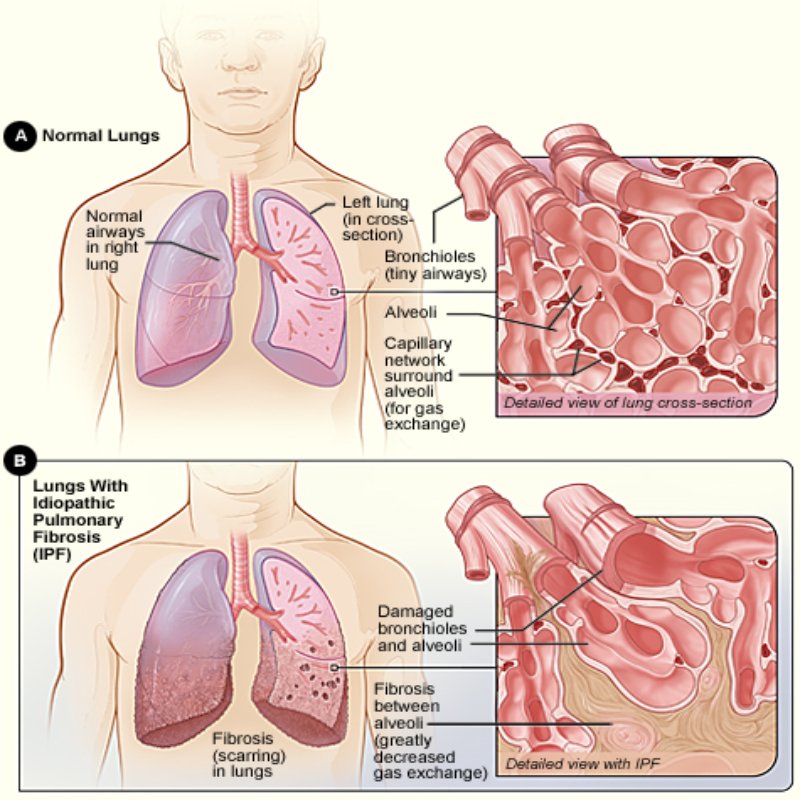Unveiling the Mystery of Idiopathic Pulmonary Fibrosis (IPF)

Idiopathic Pulmonary Fibrosis (IPF) is a rare and often misunderstood lung condition that affects thousands of individuals worldwide. This debilitating disease can severely impact a person’s quality of life, and yet, many people remain unaware of its existence or its devastating effects. In this blog, we will delve into the world of IPF, exploring its causes, symptoms, diagnosis, and treatment options to shed light on this mysterious and challenging lung disorder.
What is Idiopathic Pulmonary Fibrosis?
IPF is a progressive and irreversible lung disease that falls under the broader category of interstitial lung diseases (ILDs). It is characterized by the scarring of lung tissue, leading to the thickening and stiffening of the lung’s air sacs (alveoli). As a result, the affected individual experiences reduced lung capacity, making it increasingly difficult to breathe.
The term “idiopathic” in IPF means that the cause of the disease is unknown, adding to the complexity and mystery surrounding this condition. While the exact cause remains elusive, several risk factors and genetic factors have been associated with IPF.
Symptoms of IPF
IPF typically presents with a range of symptoms that may progress over time. Common symptoms include:
- Persistent, Dry Cough: An unrelenting cough that doesn’t produce mucus is often an early sign of IPF.
- Shortness of Breath: Individuals with IPF may experience progressive shortness of breath, particularly during physical activity.
- Fatigue: Reduced lung function can lead to fatigue and a lack of energy, making daily activities more challenging.
- Chest Discomfort: Some people with IPF report a dull, aching discomfort in the chest.
- Clubbing of Fingers and Toes: In some cases, the fingertips and toes may become enlarged and rounded.
Diagnosis of IPF
Diagnosing IPF can be complex, as its symptoms often overlap with other lung conditions. To make a precise diagnosis, healthcare professionals use a combination of tests and assessments, which may include:
- High-Resolution CT Scan (HRCT): This specialized imaging technique provides detailed images of the lungs, allowing doctors to detect signs of fibrosis.
- Pulmonary Function Tests (PFTs): These tests measure lung function and can help determine the extent of lung damage.
- Lung Biopsy: In some cases, a small tissue sample may be taken from the lungs for examination to confirm the diagnosis.
- Medical History and Physical Examination: Detailed patient history and physical exams help rule out other potential causes of lung disease.
Treatment and Management
Currently, there is no cure for IPF, but various treatment approaches can help manage the disease and improve the quality of life for affected individuals. Treatment options may include:
- Medications: Antifibrotic medications like pirfenidone and nintedanib may slow the progression of the disease and improve lung function.
- Supplemental Oxygen: Oxygen therapy can alleviate shortness of breath and improve overall oxygen levels in the blood.
- Pulmonary Rehabilitation: This comprehensive program includes exercise, education, and support to help individuals with IPF manage their symptoms and maintain physical fitness.
- Lung Transplant: For some individuals with severe IPF, lung transplantation may be considered as a last resort.
Conclusion
Idiopathic Pulmonary Fibrosis is a challenging and often underdiagnosed lung disease. While its cause remains a mystery, advances in research and treatment options offer hope for those affected by this condition. Early diagnosis and a multidisciplinary approach to care are crucial for managing IPF and improving the quality of life for individuals living with this disease. Increased awareness and ongoing research efforts are essential steps toward unraveling the mysteries of IPF and providing better outcomes for those affected by it.
The medicine I’d want to promote is pirfenidone. They don’t reverse the fibrosis but can halt the process.
GM Sanjivani is a Pirfenidone Bulk pharma Exporter, Pirfenidone third-party contract manufacturer specialized in all kinds of generic drugs.

